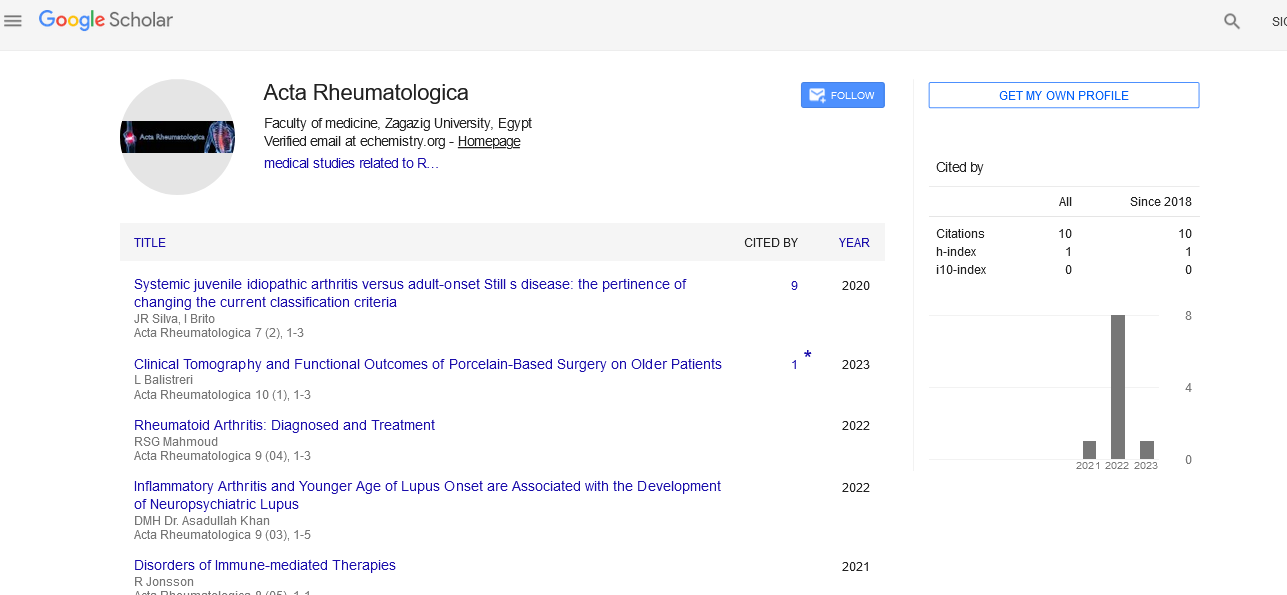Perspective - (2024) Volume 11, Issue 4
Understanding Scleroderma: Unveiling the Mysteries of a Complex Autoimmune Disease
Denis Poddubnyy*
Department of Rheumatology, University in Hamburg, Hamburg, Germany
*Correspondence:
Denis Poddubnyy, Department of Rheumatology, University in Hamburg, Hamburg,
Germany,
Email:
Received: 05-Jul-2024, Manuscript No. IPAR-24-15051;
Editor assigned: 08-Jul-2024, Pre QC No. IPAR-24-15051 (PQ);
Reviewed: 22-Jul-2024, QC No. IPAR-24-15051;
Revised: 31-Jul-2024, Manuscript No. IPAR-24-15051 (R);
Published:
08-Aug-2024
Introduction
Scleroderma, also known as Systemic Sclerosis (SSc), is a rare
autoimmune disorder that affects approximately 300,000 people
in the United States alone. Despite its low prevalence,
scleroderma can have a profound impact on individuals' lives,
causing a wide array of symptoms and complications that vary
greatly in severity and progression. In this article, we delve into
the intricacies of scleroderma, exploring its causes, symptoms,
diagnosis, treatment options, and the ongoing research efforts
aimed at improving understanding and management of this
challenging condition.
Description
What is scleroderma?
Scleroderma derives its name from Greek words meaning
"hard skin," reflecting one of its hallmark symptoms. It is
characterized by the abnormal production of collagen, a protein
that forms the connective tissue in the skin and other organs.
This excessive collagen production leads to the thickening and
hardening of the skin and can also affect internal organs such as
the lungs, heart, kidneys, and gastrointestinal tract.
Types of scleroderma
There are two main types of scleroderma: Localized
scleroderma and systemic sclerosis.
Localized scleroderma: This type primarily affects the skin and
usually remains confined to specific areas. It is less likely to
affect internal organs and tends to have a better prognosis
compared to systemic sclerosis.
Systemic Sclerosis (SSc): This form of scleroderma not only
affects the skin but also involves internal organs. Systemic
sclerosis can be further divided into limited cutaneous
scleroderma (affecting mainly the hands, face, and feet) and
diffuse cutaneous scleroderma (involving more widespread skin
thickening).
Causes and risk factors
The exact cause of scleroderma remains unknown, but researchers
believe it involves a combination of genetic predisposition and
environmental triggers. Factors such as viral infections, exposure
to certain chemicals, and abnormalities in the immune system
may play a role in its development. Women are more commonly
affected than men, and onset typically occurs between the ages
of 30 and 50, although scleroderma can occur at any age.
Symptoms
The symptoms of scleroderma can vary widely depending on
the type and severity of the disease. Common symptoms
include:
Skin changes: Thickening, hardening, and tightening of the
skin, particularly on the fingers, hands, face, and feet.
Raynaud's phenomenon: A condition in which blood vessels
in the fingers and toes constrict in response to cold
temperatures or stress, causing them to turn white or blue and
feel numb or painful.
Digestive issues: Difficulty swallowing (dysphagia), acid reflux,
and problems with the intestines.
Respiratory problems: Shortness of breath, coughing, and
pulmonary hypertension (high blood pressure in the arteries of
the lungs).
Joint and muscle pain: Stiffness and pain in the joints and
muscles.
In systemic sclerosis, internal organ involvement can lead to
more serious complications, such as heart disease, kidney
dysfunction, and pulmonary fibrosis.
Diagnosis
Diagnosing scleroderma can be challenging due to its diverse
symptoms and the variability in how they manifest in different
individuals. A combination of medical history, physical
examination, blood tests, imaging studies (such as X-rays and CT
scans), and skin biopsies may be used to confirm a diagnosis.
Early detection and intervention are crucial for managing
symptoms and preventing complications.
Treatment
While there is currently no cure for scleroderma, treatment
focuses on managing symptoms, preventing complications, and
improving quality of life. Treatment strategies may include:
Medications: Immunosuppressant’s, anti-inflammatory drugs,
and medications to improve blood flow and reduce symptoms of
Raynaud's phenomenon.
Physical therapy: Exercises to maintain joint flexibility and
improve overall physical function.
Occupational therapy: Techniques to help manage daily tasks
and maintain independence.
Lifestyle modifications: Avoiding smoking, managing stress,
protecting the skin from trauma, and maintaining a healthy diet.
In cases where internal organs are affected, specialized care
from a multidisciplinary team of healthcare providers may be
necessary.
Research and future directions
Ongoing research efforts are focused on better understanding
the underlying mechanisms of scleroderma, identifying
biomarkers for early diagnosis, and developing targeted
therapies. Clinical trials are exploring new treatment options
aimed at slowing disease progression and improving outcomes
for individuals living with this challenging condition.
Living with scleroderma
Living with scleroderma can be physically and emotionally
challenging. Support groups and patient advocacy organizations
play a crucial role in providing resources, education, and
emotional support for individuals and their families. Managing
scleroderma often requires a proactive approach to healthcare,
regular monitoring of symptoms, and open communication with
healthcare providers.
Conclusion
Scleroderma remains a complex and multifaceted
autoimmune disease that poses significant challenges for both
patients and healthcare providers. Through ongoing research
and advancements in medical care, there is hope for improved
outcomes and quality of life for individuals affected by
scleroderma. Increased awareness, early diagnosis, and
personalized treatment approaches are key to effectively
managing this condition and supporting those living with it.
As we continue to unravel the mysteries of scleroderma,
collaboration among researchers, healthcare professionals, and
patient communities will be essential in driving progress
towards better understanding, treatment, and ultimately, a cure
for this rare but impactful disease.
Citation: Poddubnyy D (2024) Understanding Scleroderma: Unveiling the Mysteries of a Complex Autoimmune Disease. Acta Rheuma Vol:11 No:4





